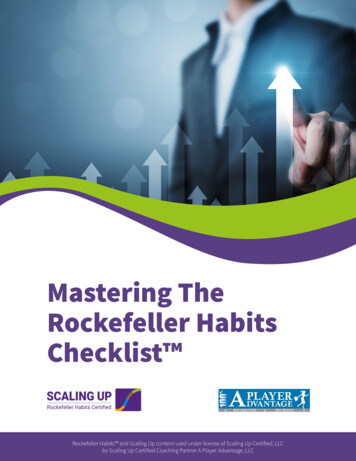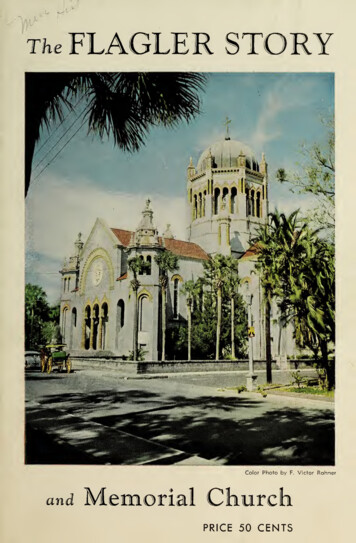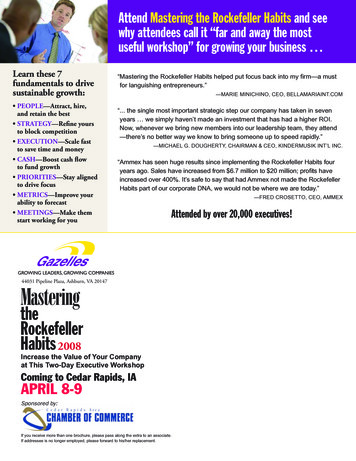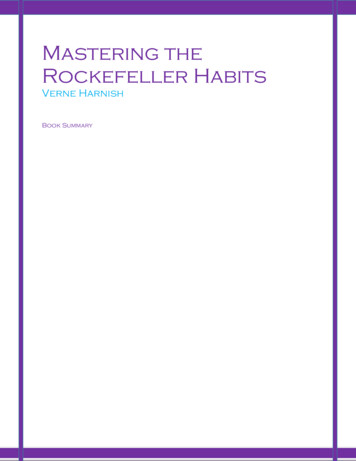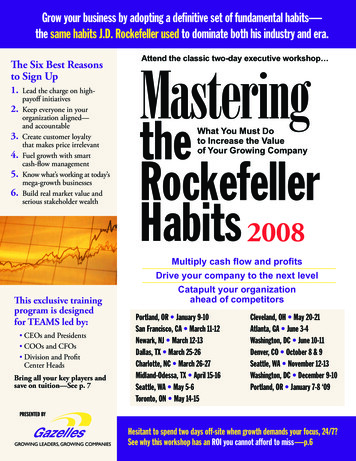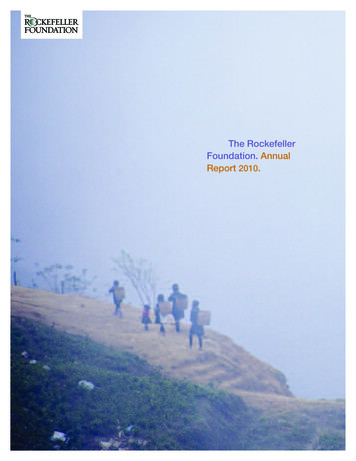
Transcription
The RockefellerFoundation. AnnualReport 2010.
president’s letter.The poet William Blake urged his readers to see the world in a grain of sand. At theRockefeller Foundation, we see the world in the lives of every individual impactedby our work.This 2010 Annual Report tells the stories of eight such individuals. They come from different backgroundsand different continents, but their personal struggles and life experiences bring into stark relief some of themost pressing global challenges we face. From food insecurity in Africa to economic insecurity in America,from cities grappling with the impact of climate change and the need for sustainable transportation, thestories in this report will give you our perspective on how critical global issues impact individual lives.Of course, these stories also illustrate solutions the Rockefeller Foundation brought to bear—and in manycases pioneered—in 2010. Here, you will read about weather-indexed crop insurance and mobile healthkiosks in Africa, interactive online tools and pilot infrastructure projects in Asian cities. From public education campaigns and policymaking advice at the state and federal levels in the U.S., to path-breakingmethods of harnessing private capital for social gain, the breadth of our work in 2010 was matched onlyby the scope of the challenges the world faced.At the beginning of the second decade of the new millennium, the ground is shifting beneath us. Theimpacts of climate change are accelerating. The global population is growing rapidly and restlessly, andmany are moving into cities, accelerating the pace of urbanization. Against this backdrop, the work ofthe Rockefeller Foundation is urgent, exciting, and continues apace. A full listing of the Foundation’s 2010grants, organized by issue area and initiative, is provided at the end of this report.Thank you for your interest in our ever-evolving efforts to build more equitable, adaptive, and resilientsocieties around the world.Judith RodinPresident
2 The Rockefeller Foundation 2010 Annual Report
The Rockefeller Foundation2010 Annual Report4Sowing the Seeds of Africa’s Green Revolution10Driving Sustainable and Equitable Transportation Policy14Building Strong Systems for Healthy Communities20Detecting Disease Through Integration24Working for a Stronger Safety Net28Innovating Within and Across Institutions32Building Climate Change Resilience382010 Trustees392010 Staff422010 Grants622010 Financials64ReferencesThe Rockefeller Foundation 2010 Annual Report 3
Sowing the Seeds ofAfrica’s Green Revolution4 The Rockefeller Foundation 2010 Annual Report
seeds of renewal.Mityana means “40 trees” in Swahili, and for years, the rural Ugandan village boasted littleother greenery. Trained agronomists were scarce and many miles away, leaving local farmers like Sebulega John Bosco uninformed about agricultural best practices. For a longtime, Sebulega recalls, he neglected to fertilize his bean fields at all.That was before Annet. Supported by the Alliance for a Green Revolution in Africa (AGRA),“agro dealer” Annet Mubiru has become one of Mityana’s most precious resources, asprized as the rain. The shelves of her modest shop carry an assortment of quality seeds,fertilizers, and pesticides. But Annet herself may be the most valuable asset, a trainedagricultural adviser offering guidance to the community’s smallholders. Thanks to Annet’ssuggestions and supplies, Sebulega increased his crop yield 150 percent, to 2.5 tons peracre. Mityana’s 40 trees now shelter a healthier, heartier harvest.1The Rockefeller Foundation 2010 Annual Report 5
A Growing ProblemUnfortunately, the vast majority of sub-Saharan Africa’s 570 million smallfarmers2 have not been as successful as Sebulega. Where Sebulega andthe rest of Mityana have ready access to agricultural advice and customizedsupplies, millions of others must trek many kilometers to the nearest agrodealer. Once there, they frequently find industrial-sized packages of seedsand other supplies too costly and heavy to bring home. Their fields liefallow, failing.Sub-Saharan Africa’s rapidly increasing population has outgrown traditionalfarming systems, threatening the income and food security of millions. Twothirds of the region3 consists of isolated agricultural communities, consignedto lives of extreme hardship and low-yield subsistence farming. Roughly onein three sub-Saharan Africans is undernourished,4 and the only thing growing reliably is the number of people in poverty.6 The Rockefeller Foundation 2010 Annual Report
A Foundation for Farming ReformIn 2006, the Rockefeller Foundation partnered with TheBill & Melinda Gates Foundation to create the Alliance fora Green Revolution in Africa (AGRA), an Africa-basedand African-led organization committed to sustainablyincreasing the productivity and profitability of small-scalefarms across Africa. Chaired by former United NationsSecretary-General Kofi Annan and working in 13 countries,5 AGRA’s concerted, system-wide approach hasled to tremendous gains in the quantity and quality ofcrops by producing new seed varieties, new systems ofwater management and enhanced soil fertility, and morerecently a Market Access Program enabling smallholdersto better market what they produce. By building newstorage and processing facilities, and giving farmers thetools to compete in the regional and global marketplace,AGRA’s market program is projected to result in a 50 percent increase in income and a 50 percent decrease infood insecurity for farming families.6In the next decade, AGRA aims to cut food insecurity inhalf in 20 African countries, and double the incomes of20 million small farmers.7The Rockefeller Foundation 2010 Annual Report 7
Reviving the RevolutionIt was the genius of field agricultural scientists like Norman Borlaug—funded by Rockefeller Foundation investments—that unleashed the GreenRevolution in Central America and Asia, credited with saving a billionlives.8 Simply shrinking a stalk of wheat dramatically grew crop yields andincomes. Over half a century later, the Rockefeller Foundation remains justas dedicated to the belief that productivity growth is a powerful driver ofpoverty reduction.Innovative, integrated initiatives like AGRA reach across all sectors ofsociety, leveraging the power of individuals—whether farmers, agriculturalresearchers, or government officials—to make smarter use of globalresources. As Mityana flourishes, as the world works to address thedisparities of the 21st century, the Rockefeller Foundation will continueto focus on food security, and AGRA will be part of the answer.8 The Rockefeller Foundation 2010 Annual Report
The Rockefeller Foundation 2010 Annual Report 9
Driving Sustainable andEquitable Transportation Policy10 The Rockefeller Foundation 2010 Annual Report
the cost of a commute.In 2006, buying an SUV and moving to the San Francisco suburbs made sense for Darren.Then he lost his full-time job as a security guard and took two part-time jobs, driving further, seven days a week, for a smaller salary. Public transit cannot get Darren to where heneeds to go. The roads and bridges he travels are among the most structurally deficient inthe nation,1 causing delays and costing additional fuel. Every month Darren spends 500for gas, 515 for car payments, 80 for insurance, and 180 for tolls—over half his salaryjust commuting to work—and gas prices could rise precipitously at any time.2A driver with a story like Darren’s sits in many of the cars around him on his frustratingmorning commute. Each year, traffic takes a toll beyond the tollbooth, costing Americans4.2 billion hours and 87 billion in productivity and wasted fuel.3 Middle-class householdsspend more on their cars and gas than on taxes and healthcare.4 It is the second highestexpense for American families, and the highest for lower income households, who spenda staggering 30 percent of their income on transportation.5The aging transportation infrastructure in the United States fails to service areas where itis desperately needed, lagging woefully behind other countries at great cost to Americancompetitiveness. One out of every nine U.S. bridges needs serious structural repair.6Meanwhile over the last decade, China has invested 3.3 trillion in cutting-edge infrastructure,7 much of it in public transportation that is fuel-efficient and gets people to where thejobs are. But instead of meeting these challenges—ensuring that U.S. transportation policyis thoughtful, sustainable, and equitable—Congress is as gridlocked as the roads. Whenit comes to the systems that help us get where we’re going, the U.S. has no focused,financed plan for where it’s headed—and, like Darren and millions of commuters, we’regoing nowhere fast.The Rockefeller Foundation 2010 Annual Report 11
Promoting Direction and DriveThe Rockefeller Foundation is working to provide the direction and drive needed to build a 21st centurytransportation system. In 2010, Rockefeller’s Transportation Initiative funded a scenario-planning exercisefor key stakeholders to map creative paths toward federal legislative reform in transportation policy.Rockefeller is working closely with policymakers at the state and local level, where significant transportationinvestments are made. And in September 2010, a Rockefeller-supported campaign to reduce greenhousegas emissions from cars through expanded public transit achieved a major milestone when the CaliforniaAir Resources Board approved aggressive standards for the state.Rockefeller is also committed to increasing the American public’s awareness of our transportation crisis.Through a Rockefeller grant, PBS produced and aired a 90-minute documentary, “Beyond the Motor City,”which outlined the decline of the transportation infrastructure and the vital importance of rebuilding it.Another Rockefeller-funded initiative, the interactive “Energy Trap” website, highlights stories—includingDarren’s—to illustrate America’s harmful gasoline dependency. To translate awareness into action,Rockefeller also helped launch Transit Score, a free online tool that rates homes in 140 U.S. cities basedon their proximity to public transportation. The wheels of reform turn slowly, but Rockefeller is increasingthe torque through these and other transportation innovations.12 The Rockefeller Foundation 2010 Annual Report
Rebuilding a Path to the American DreamWhen John D. Rockefeller established the Rockefeller Foundation in 1913, the U.S. was rapidly industrializing. As Rockefeller grew, the foundation directed part of its energies toward the thoughtful planning of thisfantastic growth, especially as it impacted cities. When a self-taught urban theorist named Jane Jacobsapplied for a grant in 1958, Rockefeller recognized her passion and vision, leading to the creation of thefield of urban design.Among Jane Jacobs’ many insights was the belief that, as she put it, “trade in ideas, services, skills andpersonnel, and certainly in goods, demands efficient, fluid transportation and communication.”8 That beliefguides Rockefeller’s commitment to smart transportation policy today. Transportation infrastructure doesnot just move people from one place to another; it is a path to the middle class dream in countries aroundthe world.The Rockefeller Foundation 2010 Annual Report 13
Building Strong Systemsfor Healthy Communities14 The Rockefeller Foundation 2010 Annual Report
on the ground innovation.India is home to countless global call centers, but residents of the state of Bihar could noteasily call an ambulance in emergencies. A sick child or injured worker had to contact aspecific hospital, or even dial the ambulance driver’s mobile phone—information that wasvery difficult to obtain. Five years ago, the municipal government and a local computercompany created a 24-hour call center integrating existing ambulances into a single network. Now, 102 Ambulance Call Centre puts life-saving transportation just three digits away.1On a different continent, Dr. Sam Gwer wrestled with a related obstacle. Health serviceswere few and far between in rural Kenya, where even a simple check-up often meanttraveling long distances and forfeiting a day’s pay. How, then, to provide adequate medicalcare to communities unable to sustain full clinics? Dr. Gwer’s solution: a set of locally-runhealth kiosks, M-Afya Kiosks, dispensing basic health services and serving as a first lineof defense for ailing Kenyans.2The Rockefeller Foundation 2010 Annual Report 15
There are countless stories like these in the developingworld—stories of limited access to health care, andnew innovations that can dramatically improve healthcare outcomes. But even as global health spendinghas increased dramatically, access to healthcare remainsa distant dream for millions in the developing world.Achieving healthy communities will largely depend onstrengthening health systems—the networks of people,organizations, and governments committed to promotingphysical wellbeing—yet global health efforts have primarily targeted specific populations and diseases. Thesemedical advances are vitally important, but it is equallyimperative to improve countries’ capacities to reach alltheir citizens for health care.16 The Rockefeller Foundation 2010 Annual Report
Because of inadequate coverage and patchwork health systems, the cost ofillness is compounded. Travel to doctors and the cost of medicine—on topof work lost due to ill health—take its toll. The world’s poorest people paythe highest percentage of their income for health, yet end up with neither.Each year, catastrophic health expenditures force 25 million households intopoverty,3 while nearly 10 million children and half a million women die fromtreatable causes.4 We are failing to cover the costs of care at the cost ofhuman life and prosperity.The Rockefeller Foundation 2010 Annual Report 17
Strengthening SystemsOnly 40 percent of the global population benefits fromsome form of health coverage. That’s why RockefellerFoundation’s Transforming Health Systems (THS) initiativeis committed to broadening access to affordable healthservices in developing countries, with the ultimate goal ofdoubling by 2020 the number of people achieving closeto universal coverage. Throughout 2010, Rockefellermade more than 17.5 million in grants to engage localentrepreneurs, public and private organizations, andglobal health experts to focus on strengthening or changing approaches in critical but neglected areas: healthsystems stewardship, e- and mobile health approaches,and private sector integration.Both the 102 Ambulance Call Centre and Dr. Gwer’sM-Afya Kiosks are part of the Rockefeller-funded Centerfor Health Market Innovations, which consolidates anddisseminates information about creative new approachesto health systems. Along with the World Health Organization, the Public Health Foundation of India, and theWilliam A. Haseltine Foundation, Rockefeller is collecting,analyzing, and implementing these innovations, whichare being promoted at high-level symposia and on theground throughout the developing world.18 The Rockefeller Foundation 2010 Annual Report
A Public Health DynamoFrom the beginning, Rockefeller has been committed to creative, holisticthinking in the field of public health. Rockefeller researchers at the world’sfirst schools of public health—established by Rockefeller—were dogged infighting malaria, polio, and countless other public health threats. Today, acentury later, Rockefeller continues to devote its resources and energy tostrengthening the systems through which life-saving treatments flow, andmaking access more available and affordable.The Rockefeller Foundation 2010 Annual Report 19
Detecting DiseaseThrough Integration20 The Rockefeller Foundation 2010 Annual Report
symptoms unknown.A few miles outside Phnom Penh, a young boy lies in bed, his illness unknown and hisparents fearful. Their village has never seen anything like it. Within a week, dozens of peopleare hospitalized with similar symptoms. Halfway around the world, a group of doctors goabout their business, knowing how to treat this disease, but not knowing about its spreadin Cambodia. With no network to transfer critical infectious disease information, withoutopen lines of communication, thousands more fall sick. The “new” disease becomes anunchecked pandemic. By the time the right expertise is brought to bear on the problem,it’s too late—the disease has spread around the globe.In a world of global trade and travel, what’s traded fastest and travels furthest are themicrobes in every handshake. Southeast Asia, with its 600 million people and large poultrytrade, has been recognized by the World Health Organization as a global hotspot for emerging infectious diseases.1 When Hong Kong suffered a nine-month outbreak of SARS—severe acute respiratory syndrome—in 2002, it killed nearly 1,000 of the roughly 8,500infected.2 Outbreaks such as avian influenza in Southeast Asia, and Rift Valley Fever in EastAfrica, can cost countries 2–5% of GDP, in addition to the price paid in human lives.3The potential pandemics of the past few decades have severely tested the world’s abilityto work across human borders. Detection remains weak in many parts of the world. Thepublic health response has frequently been slow and fragmented. The looming threat ofinfectious disease presents humanity with a new challenge: to communicate and collaborate swifter and with greater efficiency than ever before.The Rockefeller Foundation 2010 Annual Report 21
Integration Across Regions and CountriesThe Rockefeller Foundation has invested 22 million in its Disease Surveillance Networks Initiative to helpcontain the spread of infectious diseases and pandemics by strengthening national, regional and globaldisease surveillance and response systems. Two key Rockefeller programs—the Mekong Basin DiseaseSurveillance Network and the East African Integrated Disease Surveillance Network—have connected andempowered health care workers, epidemiologists and public health officials throughout the region, leadingto a six-fold increase in cross-border disease surveillance sites over the last three years alone. In 2010,Rockefeller expanded on the successful, trans-disciplinary One Health campaign, which USAID and theAsia Development Bank have adopted as models. One Health refers to the integration of medical and veterinary science to tackle these new varieties of zoonotic diseases that move and mutate rapidly from animals to humans. These collaborations have created and strengthened a critical public health regionalnetwork, while the lessons learned have been exported across disciplines and countries.In addition to improving global public health ties, Rockefeller has helped raise the level of expertise and training on the ground. The Field Epidemiology Training Program places graduates in the top levels of governmentin Laos and Vietnam, while Rockefeller grants have transformed the tools available to doctors, allowing themto harness the power of the Internet to communicate and monitor events, understand local contexts, andanalyze new problems. At last, we are applying 21st century tools to combat 21st century health challenges.22 The Rockefeller Foundation 2010 Annual Report
A Legacy of Building BridgesThe Rockefeller Foundation is dedicated to harnessing globalization’spower to spread expertise and foster collaboration across the globe.With barriers falling, and products,people, and ideas moving fasterthan ever, Rockefeller has workedto connect health care practitioners,policy makers, and veterinarians inevery region. As illustrated by theemerging pandemics of this newcentury—SARS, avian flu, andswine flu—if we don’t move quickly,viruses will. By continuing our driveto invest in systems that coordinateefforts and share information, theRockefeller Foundation is workingto ensure that we have the ability tomeet the health challenges of aninterconnected world.The Rockefeller Foundation 2010 Annual Report 23
Working for aStronger Safety Net24 The Rockefeller Foundation 2010 Annual Report
lifesaving savings.Like millions of American workers, Teresa struggles to make ends meet. She enjoys herjob as an aide in the children’s unit of a psychiatric facility, and she works hard. Teresa’sdaughter dreams of going to college, and Teresa dreams of sending her there. But forTeresa, living paycheck-to-paycheck means that financial security—let alone college forher daughter—remains a distant dream.1A new income tax innovation is helping people like Teresa. In 2010, the IRS began to allowtaxpayers to check a box on their returns to automatically set aside a portion of theirrefund for long-term savings. Developed by the Rockefeller-supported Doorway to DreamsFund, the checkbox savings initiative incentivizes “impulse saving” at the moment lowincome workers receive their refunds. Portable, transferable savings bonds offer stabilityand high interest rates to families struggling to save, and they are just one way in whichDoorway to Dreams is enabling families to achieve newfound economic security. Teresahas begun putting away 50 each month—savings that one day may help finance herdaughter’s education.Teresa’s precarious situation highlights the breakdown of the American social contract ata time of growing economic dislocation. Competition in the global economy has led to theerosion of employer-based benefits, threatening family stability and retirement security.As long-term unemployment persists—the highest since the Depression2—unemploymentinsurance is running out. Economic shocks require resilience, but today’s workers saveonly a third of what their parents did,3 and have little to fall back on as a result.These problems are compounded by a surprising shortage of robust, reliable data on theeconomic insecurity of American workers. As policymakers engage in heated battles overthe future of unemployment benefits, Social Security, and health insurance, no index existsto gauge the most important factors determining the economic security of the averageAmerican worker. We are flying blind in economic storm clouds that will not clear for theforeseeable future.The Rockefeller Foundation 2010 Annual Report 25
Strengthening Worker WellbeingTo repair the fraying edges of our social safety net, the Rockefeller Foundationhas focused on developing quality data and utilizing it to promote evidencebased policy discussions. Supporting researchers at Yale University has led tothe development of the Economic Security Index (ESI), which will help addressthe lack of uniform measurement and understanding of economic security.Another Rockefeller project created a survey seeking to better gauge attitudestowards Social Security and ways to strengthen it for vulnerable populations.Building on this knowledge base, Rockefeller has established collaborativepartnerships for policy reform across a spectrum of worker issues. In additionto the Doorway to Dreams Fund that’s helping Teresa, Rockefeller has workedclosely with groups advocating expanded access to retirement savings,green jobs for low-income workers, and benefits for independent workers.26 The Rockefeller Foundation 2010 Annual Report
Begun in 2009, Rockefeller and the National Employment Law Project havepartnered to provide the critical support and technical expertise in 2010 thatis needed to keep our gravely threatened unemployment insurance solventand available for workers. Through these initiatives, Rockefeller intends tohelp safeguard and strengthen the wellbeing of our workers.An Opportunity to Make a LivingOur founder, John D. Rockefeller, once stated his belief that “the world owesno man a living,” but “it owes every man an opportunity to make a living.”4In many ways, that has been our guiding principle as we fight to restore andrevitalize our nation’s compact with its workers. For the 21st century American,the opportunity to make a living calls for building personal savings, improvingretirement security, ensuring secure and portable healthcare coverage, andprotecting vulnerable workers from economic shocks. The work of millionsof Americans undergirds the success of our country, and we believe it isessential to ensure their dignity and livelihood.The Rockefeller Foundation 2010 Annual Report 27
Innovating Within andAcross Institutions28 The Rockefeller Foundation 2010 Annual Report
finding innovative solutions.Convicted British criminals are sent to the Peterborough Prison, 75 miles north of London,and after serving their time, they are released. Within one year, six in ten find themselvesbehind bars again.1 Other British prisons see similar—staggeringly high—recidivism rates.Instead of rehabilitation, felons experience an endless cycle of incarceration.Now, a UK-based nonprofit, Social Finance Ltd., is trying to break that cycle. With contributions from the Rockefeller Foundation and other investors,2 Social Finance is brokeringfunding from retail investors for social programs that studies show is helping former prisoners find employment and rebuild their lives and thus reduce recidivism. Social Financehas struck a deal with the British government; if the private social programs funded byinvestors can measurably reduce recidivism, the government will repay Social Finance’sinvestors back with interest. If these private programs fail to meet certain benchmarks, thegovernment pays nothing. It’s an intriguing new compact between the private and publicsectors—a “social impact bond”—and it could go a long way toward tackling social ills.3Even when we know problems are being adequately addressed, changing is challenging.Recently, the Obama administration successfully implemented a federal home nursingprogram—33 years after studies demonstrated its effectiveness.4 Some of the most creative, well validated and potentially ground-breaking approaches to intractable societalissues languish in think tanks or Congress, lacking support or political will. Money is tight,especially in these times, and new solutions mean diverting funds from existing programswith no guarantee of success. It’s tough to innovate on the taxpayer’s dime.The Rockefeller Foundation 2010 Annual Report 29
Paying for SuccessBy transferring risk from the taxpayer to theinvestor, social impact bonds hold the promise ofimplementing innovative, results oriented, and costeffective solutions.The social sector innovates and tests, and the government rewards measurable gains. These are “payfor success” bonds, and their widespread application could lead to tremendous improvements, fromincreasing kindergarten readiness to decreasinghospital readmissions for the chronically ill.Understanding the potential of social impact bonds,Rockefeller was a cornerstone investor in SocialFinance for their Peterborough Prison pilot.5 TheFoundation has since committed to promoting socialimpact bonds in the U.S., funding the NonprofitFinance Fund to create an online information-sharingplatform.6 These efforts have created a great deal ofpublicity and interest; the governments of Minnesotaand Massachusetts are exploring social impactbonds, and President Obama has proposed settingaside 100 million for seven pilot programs.730 The Rockefeller Foundation 2010 Annual Report
A Century of InnovationThe Rockefeller Foundation has always devoted itself to the pursuit ofparadigm-changing approaches to societal challenges. Some of Rockefeller’smost successful and gratifying initiatives have taken place by moving freelybetween the social, private and public sectors, seeding capital, ideas, andsolutions. Social impact bonds are just another means to harness therespective advantages of each sector. They formalize and catalyze thebonds between all of us, stakeholders in a new century.The Rockefeller Foundation 2010 Annual Report 31
Building ClimateChange Resilience32 The Rockefeller Foundation 2010 Annual Report
from country to city.The sun beats down on Suranga and her five children, as they trudge toward the speckof city in the distance. It’s hot—much hotter than in previous years—and the children arewilting like the grain the family grew until recently. The great monsoons, called “India’sfinance minister” for their critical role in determining crop yields and global commoditiesprices, come more erratically now, starving some villages and flooding others.1 Abandoningthe family’s ancestral community was hard, but not as hard as survival had become. In thecity, the mother wants to believe, all will be secure and successful.That urban utopia never materializes. Swallowed up by the city, the family finds itself facingnew challenges, a different kind of precarious existence. Their fellow migrants throng thethoroughfares, competing for food, water, and jobs. Open sewage carries disease amongthe densely-packed people. When the next flood comes, chaos will ensue. Despairing, themother sees that the consequences of the changing climate loom as large in the city as inthe country. The right response, she realizes, is not relocation, but becoming more resilient.The Rockefeller Foundation 2010 Annual Report 33
An Inescapable DilemmaAs global temperatures rise, sea levels, the frequency and intensity of natural disasters, and agriculturalupheaval will rise as well. Crop yields in sub-Saharan Africa are projected to fall 10–20 percent by 2050,2 ata time when the region’s population will surpass even India’s explosive growth.3 By mid-century, the U.N.estimates that climate change will have displaced more than 150 million environmental refugees—including23 million in the U.S. alone.They will seek salvation in cities. Already in the developing world, 1 million people are moving to urbancente
This 2010 Annual Report tells the stories of eight such individuals. They come from different backgrounds . the rest of Mityana have ready access to agricultural advice and customized supplies, millions of others must trek many kilometers to the nearest agro dealer. Once there, they frequently find industrial-sized packages of seeds

